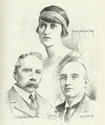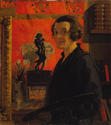 Despite the World Wars, ease of travel typifies this period. Glasgow's artists actively sought out the vibrant art scene in Paris, the stimulation of London or the solitary expanses of the Scottish coastline.
Despite the World Wars, ease of travel typifies this period. Glasgow's artists actively sought out the vibrant art scene in Paris, the stimulation of London or the solitary expanses of the Scottish coastline.
 Although the artistic roots of the four Scottish Colourists, F C B Cadell (1883-1937), J D Fergusson (1874-1961), G L Hunter (1877-1931) and S J Peploe (1871-1935), were largely in the east of Scotland, these artists were influenced by the success of the Glasgow Boys. G L Hunter settled in Glasgow in 1906. His treatment of traditional subjects - portraits, landscapes and still lifes – is enlivened by his love of rich colour and spontaneous handling. J D Fergusson spent much of his time until 1939 in Paris before settling in Glasgow. His bold, powerful and rhythmic paintings continued the painterly tradition of the Boys.
Although the artistic roots of the four Scottish Colourists, F C B Cadell (1883-1937), J D Fergusson (1874-1961), G L Hunter (1877-1931) and S J Peploe (1871-1935), were largely in the east of Scotland, these artists were influenced by the success of the Glasgow Boys. G L Hunter settled in Glasgow in 1906. His treatment of traditional subjects - portraits, landscapes and still lifes – is enlivened by his love of rich colour and spontaneous handling. J D Fergusson spent much of his time until 1939 in Paris before settling in Glasgow. His bold, powerful and rhythmic paintings continued the painterly tradition of the Boys.
 Two important artists of the later period, Robert Colquhoun (1914-1962) and Robert MacBryde (1913-1966), met when they enrolled at Glasgow School of Art in 1933. Much of the rest of their life was spent in London. Colquhoun's expressive figurative works led to him being hailed as the leading British artist of the day, but were soon deemed old-fashioned in comparison to abstraction. The influence of his work on Glasgow artists, however, continues to this day.
Two important artists of the later period, Robert Colquhoun (1914-1962) and Robert MacBryde (1913-1966), met when they enrolled at Glasgow School of Art in 1933. Much of the rest of their life was spent in London. Colquhoun's expressive figurative works led to him being hailed as the leading British artist of the day, but were soon deemed old-fashioned in comparison to abstraction. The influence of his work on Glasgow artists, however, continues to this day.
 The "two Roberts" had been strongly influenced by the magnificent draughtsmanship of James Cowie (1886-1956) who, while teaching for some twenty years at Bellshill Academy near Glasgow, had drawn schoolchildren. Cowie's work in turn must have influenced that of the enigmatic Joan Eardley (1921-1963) who, after studying at Glasgow School of Art and travelling on the continent, set to work in the Gorbals painting street children in oil, pastel and chalks.
The "two Roberts" had been strongly influenced by the magnificent draughtsmanship of James Cowie (1886-1956) who, while teaching for some twenty years at Bellshill Academy near Glasgow, had drawn schoolchildren. Cowie's work in turn must have influenced that of the enigmatic Joan Eardley (1921-1963) who, after studying at Glasgow School of Art and travelling on the continent, set to work in the Gorbals painting street children in oil, pastel and chalks.